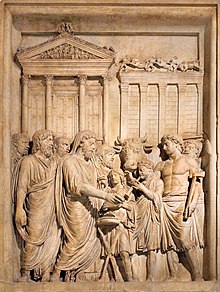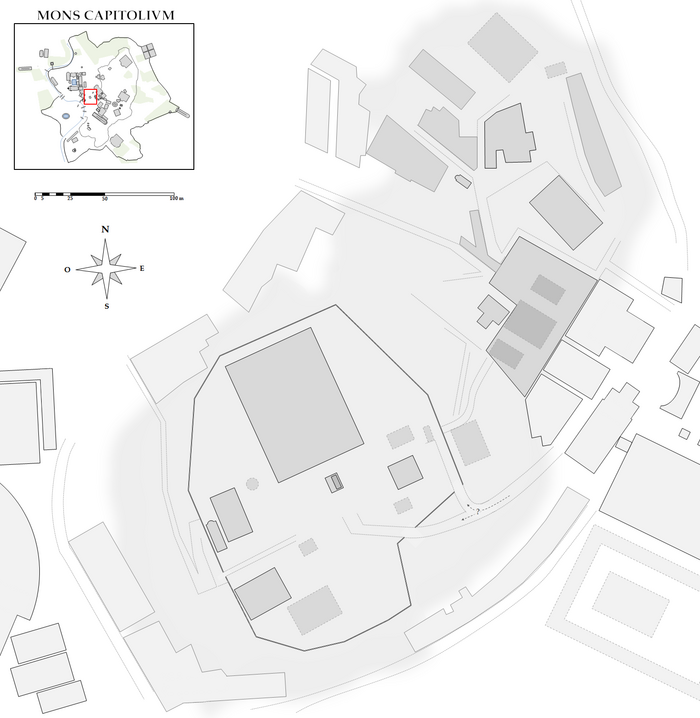Temple of Jupiter Optimus Maximus
 Speculative model of the first Temple of Jupiter Optimus Maximus, 509 BC | |
 Click on the map for a fullscreen view | |
| Coordinates | 41°53′32″N 12°28′54″E / 41.89222°N 12.48167°E |
|---|---|

The Temple of Jupiter Optimus Maximus, also known as the Temple of Jupiter Capitolinus (
Traditionally dedicated in 509 BC,
The first version is the largest Etruscan-style temple recorded,[3] and much larger than other Roman temples for centuries after. However, its size remains heavily disputed by specialists; based on an ancient visitor it has been claimed to have been almost 60 m × 60 m (200 ft × 200 ft), not far short of the largest Greek temples.[4] Whatever its size, its influence on other early Roman temples was significant and long-lasting.[5] Reconstructions usually show very wide eaves, and a wide colonnade stretching down the sides, though not round the back wall as it would have done in a typical Greek temple.[6] A crude image on a coin of 78 BC shows only four columns, and a very busy roofline.[7]
With two further fires, the third temple only lasted five years, to 80 AD, but the fourth survived until the fall of the empire. Remains of the last temple survived to be pillaged for spolia in the Middle Ages and Renaissance, but now only elements of the foundations and podium or base survive; as the subsequent temples apparently reused these, they may partly date to the first building. Much about the various buildings remains uncertain.
History
First building
Much of what is known of the first Temple of Jupiter is from later Roman tradition. King Lucius Tarquinius Priscus vowed this temple while battling with the Sabines[8] and, according to Dionysius of Halicarnassus, began the terracing necessary to support the foundations of the temple.[9] Much of the Cappellaccio tufa which forms the foundation of the Temple was probably mined directly from the site when it was excavated and levelled for the structure.[10] Modern coring on the Capitoline has confirmed the extensive work needed just to create a level building site.[11] According to Dionysius of Halicarnassus and Livy, the foundations and most of the superstructure of the temple were completed by Lucius Tarquinius Superbus, the last King of Rome.[12]
Livy also records that before the temple's construction shrines to other gods occupied the site. When the augurs carried out the rites seeking permission to remove them, only Terminus and Juventas were believed to have refused. Their shrines were therefore incorporated into the new structure. Because he was the god of boundaries, Terminus's refusal to be moved was interpreted as a favorable omen for the future of the Roman state. A second portent was the appearance of the head of a man to workmen digging the foundations of the temple. This was said by the augurs (including augurs brought especially from Etruria) to mean that Rome was to be the head of a great empire.[13]
Livy reports that the Temple was dedicated on September 13 in the year the
The original temple may have measured almost 60 m × 60 m (200 ft × 200 ft), though this estimate is hotly disputed by some specialists.
The original temple decoration was discovered in 2014. The findings allowed the archaeologists to reconstruct for the first time the real appearance of the temple in the earliest phase.[20] The wooden elements of the roof and lintels were lined with terracotta revetment plaques and other elements of exceptional size and richly decorated with painted reliefs, following the so-called Second Phase model (referring to the decorative systems of Etruscan and Latin temples), that had its first expression precisely with the Temple of Jupiter Optimus Maximus. The temple, which immediately rose to fame, established a new model for sacred architecture that was adopted in the terracotta decorations of many temples in Italy up to the 2nd century BC. The original elements were partially replaced with other elements in different style in the early 4th century BC and anew at the end of the 3rd – early 2nd century BC. The removed material was dumped into the layers forming the square in front of the temple, the so-called Area Capitolina, in the middle years the 2nd century BC.[21]
Repairs and improvements were undertaken over the course of the temple's lifetime, including the re-stuccoing of the columns and walls in 179 BC, the addition of mosaic flooring in the cella after the Third Punic War, and the gilding of the coffered ceiling inside the cella in 142 BC. Over the years the temple accrued countless statues and trophies dedicated by victorious generals, and in 179 some of these attached to the columns were removed to lessen the clutter.[10]
The plan and exact dimensions of the temple have been heavily debated.[22] Five different plans of the temple have been published following recent excavations on the Capitoline Hill that revealed portions of the archaic foundations.[23] According to Dionysius of Halicarnassus, the same plan and foundations were used for later rebuildings of the temple,[24] but there is disagreement over what the dimensions he mentions referred to (the building itself or the podium).
In 437 BC
The first temple burned in 83 BC, during the civil wars under the dictatorship of
-
Speculativeplanof the first temple
-
Another of the many guesses at a plan
-
Back wall in 2005
Second building

During Lucius Cornelius Sulla's sack of
Third building
The new emperor, Vespasian, rapidly rebuilt the temple on the same foundations but with a lavish superstructure. It was taller than the previous structures, with a Corinthian order and statuary including a quadriga atop the gable and bigae driven by figures of Victory on either side at the base of the roof.[28] The third temple of Jupiter was dedicated in 75 CE.[30] The third temple burned during the reign of Titus in 80 CE.
Fourth building

Decline and abandonment
The temple completed by Domitian is thought to have lasted more or less intact for over three hundred years, until all pagan temples were closed by Emperor
Remains
Today, portions of the temple podium and foundations can be seen behind the
The second Medici lion was sculpted in the late 16th century by Flaminio Vacca from a capital from the Temple of Jupiter Optimus Maximus.[38]
Area Capitolina
The Area Capitolina was the precinct on the southern part of the Capitoline that surrounded the Temple of Jupiter, enclosing it with irregular retaining walls following the hillside contours.
Underground chambers called favissae held damaged building materials, old
| Capitoline Hill plan |
|---|

Area Capitolina Forum Romanum Iseum
Temple of
Concord (?) Altar
Centus
Gradus Porta Pandana
Temple of Hope (Spes) Temple of Juno Sospita Inter duos lucos
Tullianum Clivus Argentarius Temple of
Fides (?) Temple
of Ops(?) |
See also
Footnotes
- Ab urbe condita, 2.8
- ^ Stamper, 12–13; Galluccio, 237–291
- ^ Christofani; Boethius, 47
- ^ Boethius, 47–48
- ^ Stamper, 33 and all Chapters 1 and 2. Stamper is a leading protagonist of a smaller size, rejecting the larger size proposed by the late Einar Gjerstad.
- ^ Christofani
- ^ Denarius of 78 BC
- Ab urbe condita1.38
- ^ Dionysius of Halicarnassus, Roman Antiquities 3.69
- ^ a b c Richardson, 1992; p. 222
- ^ Ammerman 2000, pp. 82–83
- ^ Dionysius of Halicarnassus, Roman Antiquities 4.61; Livy History 1.55–56.1
- Ab urbe condita1.55
- Ab urbe condita, 2.8
- ^ Tacitus, quoted in Aicher 2004, p. 51
- Ab urbe condita, 2.22
- ^ Mura Sommella 2000, p. 25 fig. 26; Stamper 2005, p. 28 fig. 16; Albertoni & Damiani 2008, p. 11 fig. 2c; Cifani 2008, p. 104 fig. 85; Mura Sommella 2009, pp. 367–368 figs. 17–19; Kaderka & Tucci 2021, p. 151 fig. 4
- ^ Pliny the Elder, Encyclopedia 35.157
- ^ Cicero, On Divination 1.16
- ^ Galluccio 2016, 237–250, fig. 9
- ^ Galluccio 2016, 250–256, figs. 10–13
- ^ Ridley 2005
- ^ Mura Sommella 2000, p. 25 fig. 26; Stamper 2005, p. 28 fig. 16; Albertoni & Damiani 2008, p. 11 fig. 2c; Cifani 2008, p. 104 fig. 85; Mura Sommella 2009, pp. 367–368 figs. 17–19.
- ^ Dionysius of Halicarnassus, Roman Antiquities 4.61.4
- ^ Pliny NH 7.138; Tacitus Hist. 3.72.3.
- ^ Flower 2008, p. 85
- ^ Coarelli, 2014; p. 34
- ^ a b c Richardson, 1992; p. 223
- ^ Tacitus Hist. 3.71–72
- ^ Darwall-Smith 1996, pp. 41–47
- ^ Plutarch. Life of Pulicola. 15.3–4.
- ^ "Coins: the Temple through Time". Omeka. Retrieved 24 January 2019.
- ^ a b c d Samuel Ball Platner & Thomas Ashby (1929). "A Topographical Dictionary of Ancient Rome". Oxford University Press. pp. 297–302.
- ^ Ammianus Marcellinus, The Roman History XXII.16.12
- ^ Cassiodorus, Variae epistolae VII.6
- ^ Claridge 1998, pp. 237–238; Albertoni & Damiani 2008
- ^ Coarelli, 2014; p. 32
- ISBN 8809026209
- ^ Livy 25.3.14; Velleius Paterculus 2.3.2; Aulus Gellius 2.102; Lawrence Richardson, A New Topographical Dictionary of Ancient Rome (Johns Hopkins University Press, 1992), p. 31.
- ^ Livy 6.4.12; Richardson, A New Topographical Dictionary, p. 31.
- ^ Adam Ziolkowski, "Civic Rituals and Political Spaces in Republican and Imperial Rome," in The Cambridge Companion to Ancient Rome (Cambridge University Press, 2013), p. 398.
- ^ Cicero, Rosc. Am. 56; Gellius 6.1.6; Richardson, A New Topographical Dictionary, p. 31.
- ^ Tacitus, Histories 3.75; Richardson, A New Topographical Dictionary, p. 31.
- ^ Richardson, A New Topographical Dictionary, p. 32.
- ^ Ziolkowski, "Civic Rituals and Political Spaces," p. 398.
- ^ Sidonius Apollinaris, Epistulae 1.7.8; Claire Holleran, Shopping in Ancient Rome: The Retail Trade in the Late Republic and the Principate (Oxford University Press, 2012), 251.
References
- Aicher, Peter J. (2004), Rome Alive: A Source Guide to the Ancient City, Wauconda, IL: Bolchazy-Carducci, ISBN 0865164738.
- Albertoni, M.; Damiani, I. (2008), Il tempio di Giove e le origini del colle Capitolino, Milan: Electa.
- Ammerman, Albert (2000), "Coring Ancient Rome", Archaeology: 78–83.
- ISBN 978-0300052909, google books
- Cristofani, Mauro, et al. "Etruscan", Grove Art Online, Oxford Art Online. Oxford University Press, accessed April 9, 2016, subscription required
- Cifani, Gabriele (2008), Architettura romana arcaica: Edilizia e società tra Monarchia e Repubblica, Rome: "L'Erma" di Bretschneider.
- Darwall-Smith, R. H. (1996), Emperors and Architecture: A Study of Flavian Rome, Brussels: Latomus.
- Claridge, Amanda (1998), Rome, Oxford Archaeological Guides, Oxford Oxfordshire: Oxford University Press, ISBN 0-19-288003-9.
- Coarelli, Filippo (2014), Rome and Environs: An Archaeological Guide, Berkeley & Los Angeles: University of California Press, ISBN 978-0-520-28209-4.
- Flower, Harriet I. (2008), "Remembering and Forgetting Temple Destruction: The Destruction of the Temple of Jupiter Optimus Maximus in 83 BC", in G. Gardner and K. L. Osterloh (ed.), Antiquity in Antiquity, Tubingen: Mohr Siebeck, pp. 74–92, ISBN 978-3-16-149411-6.
- Galluccio, Francesco (2016), "Il mito torna realtà. Le decorazioni fittili del Tempio di Giove Capitolino dalla fondazione all'età medio repubblicana", Campidoglio Mito, Memoria, Archeologia (Exhibit Catalog, Rome 1 March – 19 June 2016), Eds. Claudio Parisi Presicce – Alberto Danti: 237–291.
- Kaderka, Karolina; Tucci, Pier Luigi (2021), "The Capitoline Temple of Jupiter. The Best, the Greatest, but not Colossal", Römische Mitteilungen (Mitteilungen des Deutschen Archäologischen Instituts, Römische Abteilung), 127: 146–187
- Mura Sommella, A. (2000), ""La grande Roma dei tarquini": Alterne vicende di una felice intuizione", Bullettino della Commissione Archeologica Comunale di Roma, 101: 7–26.
- Mura Sommella, A. (2009), "Il tempio di Giove Capitolino. Una nuova proposta di lettura", Annali della Fondazione per Il Museo Claudio Faina, 16: 333–372.
- Richardson, Lawrence (1992). A New Topographical Dictionary of Ancient Rome. The Johns Hopkins University Press. ISBN 0-8018-4300-6.
- Ridley, R.T. (2005), "Unbridgeable Gaps: the Capitoline temple at Rome", Bullettino della Commissione Archeologica Comunale di Roma, 106: 83–104.
- Stamper, John (2005), The architecture of Roman temples: the republic to the middle empire, New York: Cambridge University Press. [ISBN missing]



